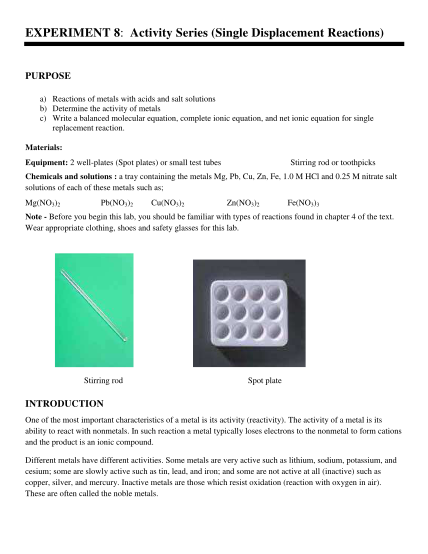Have you ever wondered why some metals react readily with acids while others remain untouched? Or why certain metals can displace others from their compounds? The answers lie within the fascinating realm of the activity series, a powerful tool for predicting and understanding chemical reactions. In this comprehensive guide, we’ll delve into the intricacies of the activity series, demystifying its secrets and equipping you with the knowledge to confidently navigate the world of chemical reactions.

Image: athensmutualaid.net
The activity series, also known as the reactivity series, is a chart that ranks different metals and nonmetals based on their tendency to lose or gain electrons. This ranking provides valuable insights into the likelihood of various chemical reactions occurring. It can predict whether a particular metal will displace another metal from a solution, or whether a reaction will even take place at all. Understanding the activity series is essential for comprehending the fundamental principles of chemistry and its applications in various fields, from everyday life to cutting-edge research.
Diving Deep into the Activity Series
The activity series is a hierarchical list of elements, primarily metals, arranged in decreasing order of their reactivity. Metals at the top of the series are highly reactive, readily losing electrons and participating in chemical reactions. Conversely, metals at the bottom are less reactive, exhibiting a weaker tendency to lose electrons. This series is a valuable tool for predicting the outcome of reactions between metals with acids, salts, and even other metals.
The Core Principles:
-
Displacement Reactions: The activity series enables us to predict the direction of a displacement reaction. A more reactive metal will displace a less reactive metal from its compound. For example, zinc (Zn) is more reactive than copper (Cu), so zinc will displace copper from a copper sulfate solution, resulting in the formation of zinc sulfate.
-
Reactions with Acids: The activity series reveals which metals will react with acids to form hydrogen gas. Metals above hydrogen in the series react with acids, releasing hydrogen gas, while those below hydrogen do not. For instance, magnesium (Mg) reacts readily with hydrochloric acid (HCl) to produce magnesium chloride (MgCl2) and hydrogen gas (H2), while copper (Cu) remains unreactive.
-
Reactions with Oxygen: The activity series also dictates the reactivity of metals with oxygen. More reactive metals readily react with oxygen to form oxides. For example, sodium (Na) reacts vigorously with oxygen to produce sodium oxide (Na2O), while gold (Au) remains inert in the presence of oxygen.
Beyond Metals:
The activity series isn’t limited to just metals. Nonmetals, like halogens, also exhibit varying reactivity. The activity series for halogens is arranged in decreasing order of reactivity: fluorine (F2) > chlorine (Cl2) > bromine (Br2) > iodine (I2). This series helps predict the outcome of reactions between halogens and halides.
Mastering the Activity Series: Tools and Techniques
To make the most of the activity series, it’s vital to understand its fundamental principles and how it applies to different chemical reactions. Here are some valuable techniques:
Visualizing the Series:
-
Charts and Diagrams: A well-organized table or diagram depicting the activity series is an invaluable visual aid for understanding reactivity trends.
-
Memory Aids: Consider using mnemonic devices, such as acronyms or rhymes, to remember the relative positions of metals within the series.
Practical Applications:
-
Predicting Reactions: Use the series to predict whether a specific reaction will occur and its products. For example, will iron (Fe) react with hydrochloric acid (HCl)? The activity series indicates that iron is more reactive than hydrogen, so the reaction will occur, liberating hydrogen gas.
-
Balancing Equations: Knowing the activity series helps write balanced chemical equations for reactions involving metals and acids, ensuring that the correct products are formed.
-
Real-world Applications: The activity series plays a crucial role in various practical applications, such as electroplating, corrosion prevention, and the design of batteries.
Expert Insights and Actionable Tips
Embrace the Power of Observation:
-
Laboratory Experiments: Conducting laboratory experiments allows for firsthand observation of the reactions predicted by the activity series. This hands-on experience reinforces your understanding and enables you to interpret experimental results.
-
Real-world Phenomena: Observe the world around you and identify scenarios where the activity series plays a role. For example, the corrosion of iron is a direct consequence of its reactivity with oxygen and moisture.
Mastering the Art of Prediction:
-
Apply the Series: Use the series to predict the outcome of reactions, even in novel scenarios. For instance, you can predict whether a new alloy (a mixture of metals) will react with a specific acid.
-
Critical Thinking: While the activity series is a valuable tool, it’s essential to exercise critical thinking. Consider factors like temperature and concentration that can influence reaction rates and outcomes.

Image: cocodoc.com
Pogil The Activity Series Answer Key
Conclusion
The activity series is a fundamental concept in chemistry, offering a powerful tool for understanding and predicting the behavior of metals and nonmetals in chemical reactions. By mastering the principles of the activity series, you gain a deeper understanding of chemical processes and their real-world applications. From predicting the outcome of displacement reactions to designing innovative materials, the activity series provides a framework for navigating the intricate world of chemistry. Remember, the key to unlocking the secrets of this essential tool lies in inquisitive observation, the application of knowledge, and a willingness to embrace the captivating nature of chemical reactions.




